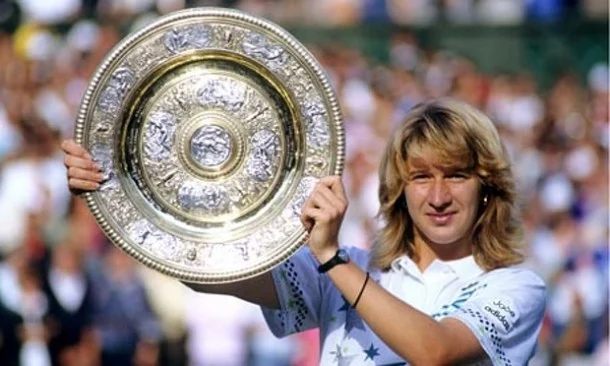In the rich tapestry of tennis, Steffi Graf remains a towering figure, distinguished not only by her dynamic play but also by her unmatched achievements in the Grand Slams. Known for her explosive forehand and rapid gameplay, Graf has made a lasting impact on tennis. Her crowning glory was in 1988, a year in which she achieved the Steffi Graf Grand slams, an unparalleled feat where she won all four major singles titles and the Olympic gold within the same calendar year. This monumental achievement established Graf as the inaugural Golden Slam champion, setting a benchmark of excellence that continues to motivate sportspeople globally.
Early life and career beginnings
Born on June 14, 1969, in Mannheim, West Germany, Steffi Graf embarked on her tennis journey at an early age, showing promise by the age of three under her father’s guidance. Her prodigious talent became evident as she entered and won her first tournament at five. Graf’s ascent in the international tennis arena was meteoric; by 1982, she had already turned professional at the tender age of 13. Her breakout year came in 1984 when she claimed her first WTA title, signaling her arrival on the global stage.
The early victories in Graf’s career were crucial, as they provided her with the confidence and exposure necessary to compete on the sport’s biggest stages. Her prowess on the court quickly drew attention, setting the stage for what would become a legendary career. These formative years laid the foundation for her future success, marking the beginning of her quest for the career golden slam—a goal she pursued with relentless determination and skill.
Breakthrough and dominance
Steffi Graf’s climb to tennis supremacy accelerated in the mid-1980s. By 1987, she had established herself as a force to be reckoned with, dethroning Martina Navratilova to become the world No. 1—a title she claimed after her first significant victory at the French Open. This victory was not just a tournament win; it was a declaration of her readiness to dominate the sport. Her game, characterized by a formidable forehand and exceptional speed, became the cornerstone of her success.
Key victories and game style evolution
The year 1988 was pivotal for Graf as she achieved the Steffi Graf Grand Slams milestone. Winning all four Grand Slam tournaments and the Olympic gold in the same year, she not only showcased her versatility across different surfaces but also her mental and physical endurance. Graf’s ability to adapt her playstyle to match the surface and opponent made her virtually unbeatable. Her wins at Wimbledon and the U.S. Open against top competitors like Navratilova and Chris Evert highlighted her strategic depth and tactical intelligence.
These early years of dominance solidified her status and set a new benchmark in tennis. Graf’s style evolved from merely powerful to strategically masterful, allowing her to maintain her position at the top of the world rankings and pursue what would eventually be known as the career golden slam. Her impact on the game was profound, as she pushed the boundaries of what was possible in professional tennis with each match and victory.
1988 Australian Open: The start of something special
The 1988 Australian Open marked the beginning of an extraordinary year for Steffi Graf, setting the stage for her historic Golden Slam. Graf’s performance at this tournament was a clear indication of the dominance that would define her season.
- Early rounds dominance: Graf breezed through the initial rounds, showcasing her exceptional form. She displayed a blend of power and precision that overwhelmed her opponents, losing only a handful of games as she advanced to the later stages.
- Key victories: Two matches were particularly emblematic of her prowess during the tournament:
- Quarterfinals against Hana Mandlikova: Graf faced the defending champion, defeating her soundly with a score of 6-2, 6-2. This victory was significant as it underscored Graf’s readiness to take over the mantle of women’s tennis.
- Final against Chris Evert: The final was a much-anticipated clash with the third seed, Chris Evert. Graf’s performance was a masterclass in mental toughness and strategic play, winning 6-1, 7-6. This match not only highlighted her physical capabilities but also her mental fortitude in tight situations.
- Strategic play and mental toughness: Throughout the tournament, Graf demonstrated a remarkable ability to maintain focus and adapt her strategy as needed. Her aggressive baseline play, combined with a formidable serve, allowed her to control the pace of the matches.
This victory at the Australian Open was not just a triumph in a Grand Slam event; it was the first step toward achieving what no other tennis player had done before—winning all four Grand Slam tournaments and the Olympic gold in a single calendar year. Steffi Graf’s journey through the 1988 Australian Open is remembered as the start of something truly special in the world of sports.
1988 French Open: Cementing dominance on clay
At the 1988 French Open, Steffi Graf not only displayed her superiority on clay but also set the tone for what would become one of the most illustrious seasons in tennis history. Her journey through the tournament was marked by an assertive style of play that left little room for competitors to maneuver.
- Overwhelming performance: Graf’s dominance was most evident in her final match against Natasha Zvereva, where she delivered a staggering 6-0, 6-0 victory. This result, known as a “double bagel,” was unprecedented in a Grand Slam final, highlighting her unmatched skill and determination on clay courts.
- Historical significance: Graf’s victory at Roland Garros was significant not only because it was part of her quest for the Golden Slam tennis but also because it underscored her versatility and tactical genius across different surfaces. This win also marked her second consecutive French Open title, a feat that underlined her growing dominance in women’s tennis.
- Records set: The 1988 French Open final remains one of the shortest and most decisive Grand Slam finals in history, lasting just 34 minutes. Graf’s performance in this tournament is often cited as one of the most dominant displays in professional tennis.
Through her strategic play, characterized by powerful forehands and quick adaptability, Graf not only won the tournament but also solidified her reputation as the premier female tennis player of her time. This victory was a crucial part of her historic 1988 season, where she not only aimed to win every major but also to leave an indelible mark on the sport.

1988 Wimbledon: Conquering the grass
The 1988 Wimbledon Championships showcased Steffi Graf’s mastery over grass, a surface that demands agility and precision. Facing formidable opponents, Graf’s path to the title was anything but easy. One of her most notable matches was against Martina Navratilova, the six-time defending champion, in a dramatic final. Graf overcame a challenging start to claim a 5-7, 6-2, 6-1 victory, which was pivotal not only for the match but for her confidence for the rest of the season.
This triumph at Wimbledon was crucial in her quest for the Golden Slam. Winning at the All England Club, known for its prestige and the unique challenges of grass court tennis, Graf solidified her status as the season’s dominant player. The victory underscored her versatility and marked a significant milestone in her historic journey toward achieving the Golden Slam, setting her up for the remaining challenges of the year.
1988 US Open and Olympic Glory
Steffi Graf 1988 US Open campaign was a testament to her dominance and consistency. Graf breezed through the tournament, facing minimal resistance and dropping very few sets. Her final challenge at the US Open was Gabriela Sabatini, whom she defeated 6-3, 3-6, 6-1 in a match that tested her resilience and adaptability. This victory not only secured her the US Open title but also kept alive her hopes for the unprecedented Golden Slam.
Shortly after her success in New York, Graf headed to the 1988 Seoul Olympics with immense pressure and expectations. Her Olympic journey mirrored her performance throughout the year—dominant and decisive. Graf clinched the gold medal by defeating Sabatini again, this time with a straight-set victory in the finals, 6-3, 6-3. This win was not just another medal; it was the crowning achievement of her Golden Slam, making her the only tennis player ever to win all four major singles titles and the Olympic gold in the same calendar year, a feat that has yet to be replicated. This historic accomplishment marked a milestone in tennis history and solidified Graf’s legacy as one of the greatest in the sport.

Recent Comments